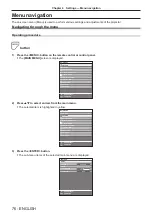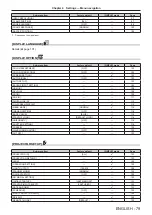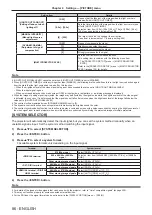
Chapter 4
Settings — [PICTURE] menu
86 - ENGLISH
Setting item
Details
[LIGHTS OUT FADE-OUT]
(Setting of fade-out when
lighting off)
[OFF]
Does not set the fade-out of the image when the light source is
turned off with [LIGHTS OUT TIMER].
[0.5s] - [10.0s]
Sets the time to fade out the image when the light source is turned
off with [LIGHTS OUT TIMER].
Select an item from [0.5s] - [4.0s], [5.0s], [7.0s], or [10.0s]. [0.5s] -
[4.0s] can be selected in increments of 0.5.
[MANUAL INTENSITY]
(Manual light source
adjustment)
[0] - [255]
The larger the value, the stronger the correction.
Can be set in increments of 1. (Factory setting: 255)
[DYNAMIC GAMMA]
(Adjustment of signal
compensation)
[OFF]
Does not compensate the signal.
[1]
Slightly compensates the signal.
[2]
Moderately compensates the signal.
[3]
Strongly compensates the signal.
[MULTI PROJECTOR SYNC]
Sets the contrast synchronization function.
This setting item is common with the following menu item.
f
The [PROJECTOR SETUP] menu
→
[MULTI PROJECTOR
SYNC]
Refer to the [PROJECTOR SETUP] menu
→
[MULTI PROJECTOR
SYNC] (
x
page 136) for details.
Note
f
[LIGHTS OUT SIGNAL LEVEL] cannot be set when [LIGHTS OUT TIMER] is set to [DISABLE].
f
When [LIGHTS OUT TIMER] is set to anything other than [DISABLE], the following are the conditions to turn the light source back on again
from the state that the light source has turned off by this function.
g
When the brightness level of the video signal being input has exceeded the value set in [LIGHTS OUT SIGNAL LEVEL]
g
When the input signal is gone
g
When on-screen display such as menu screen (OSD) or input guide, a test pattern, or a warning message is displayed
f
When the image of analog signal is projected, the image may be affected by the signal noise while the brightness level of the video signal
is detected. In such case, it is determined that the signal has not fallen below even when the brightness level of the image falls below the
value set in [LIGHTS OUT SIGNAL LEVEL].
f
The contrast will be maximized when [DYNAMIC GAMMA] is set to [3].
f
The dynamic contrast function does not operate while measuring the brightness and the color.
f
The contrast synchronization function is a function to display a combined screen with a balanced contrast by sharing the brightness level of
the video signal input to each projector when a multi-display is constructed by combining the projected image of multiple projectors.
[SYSTEM SELECTOR]
The projector will automatically detect the input signal, but you can set the system method manually when an
unstable signal is input. Set the system method matching the input signal.
1) Press
as
to select [SYSTEM SELECTOR].
2) Press the <ENTER> button.
3) Press
as
to select a system format.
f
Available system formats vary depending on the input signal.
Terminal
System format
<RGB IN> terminal
576/50p signal
Select [RGB] or [YC
B
C
R
].
640 x 480/60 or 480/60p
signal
Select an item from [640x480/60], [480/60p YC
B
C
R
], or [480/60p
RGB].
Other moving image signals
Select [RGB] or [YP
B
P
R
].
<DVI-D IN> terminal
480/60p or 576/50p signal
Select [RGB] or [YC
B
C
R
].
Other moving image signals
Select [RGB] or [YP
B
P
R
].
<HDMI IN> terminal, <DIGITAL
LINK> terminal
480/60p or 576/50p signal
Select [AUTO], [RGB], or [YC
B
C
R
].
Other moving image signals
Select [AUTO], [RGB], or [YP
B
P
R
].
4) Press the <ENTER> button.
Note
f
For details of the types of video signals that can be used with the projector, refer to “List of compatible signals” (
x
page 229).
f
This may not function properly for some connected external devices.
f
For the SDI input, the signal format can be set in detail in the [DISPLAY OPTION] menu
→
[SDI IN].
















































